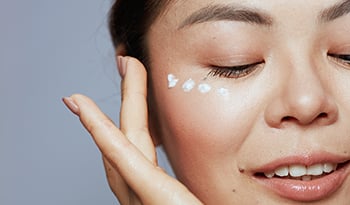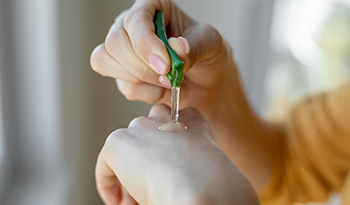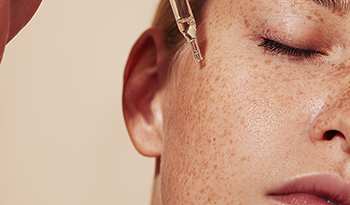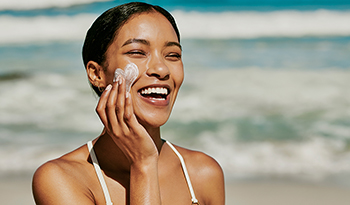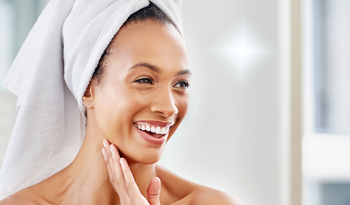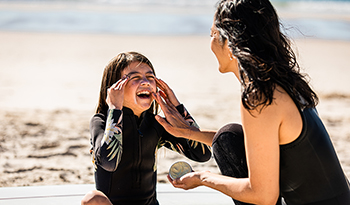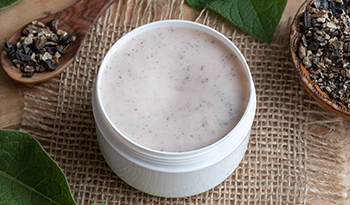Як заспокоїти обгорілу на сонці шкіру за допомогою натуральних інгредієнтів
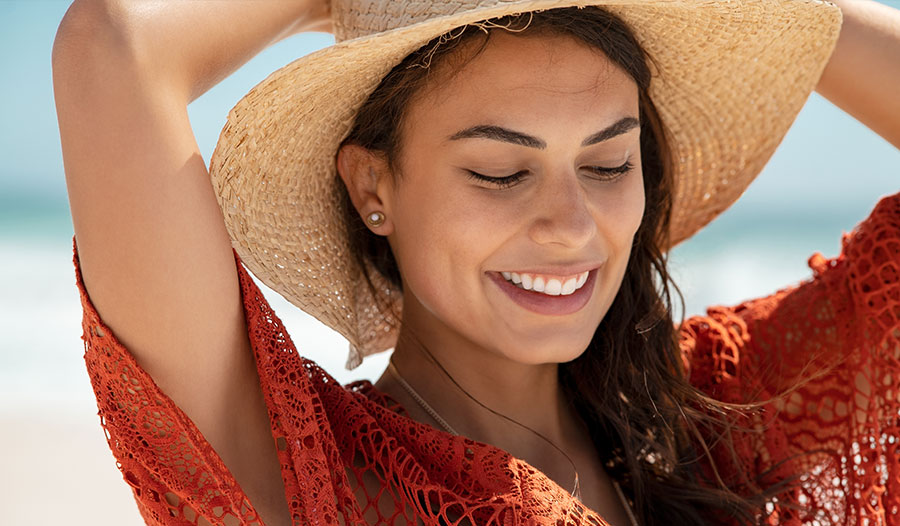
Настали літні місяці, і активний відпочинок на свіжому повітрі стає дедалі популярнішим! Ось як можна зберегти шкіру здоровою, заспокоїти її після перебування на сонці та запобігти сонячним опікам, використовуючи природні засоби.
Що трапляється, коли отримуєш сонячний опік?
Більшість людей дивуються, коли дізнаються, що сонячні опіки насправді є різновидом променевого опіку. Так, ви правильно прочитали!
Сонячне світло, яке освітлює нашу планету вдень, є лише одним з видів широкого спектру енергетичних променів, які виробляє Сонце. Інші види енергії, які випромінює сонце, включають рентгенівські промені, гамма-промені та ультрафіолетове випромінювання, і це лише деякі з них. Ультрафіолетові промені А та В іноді скорочено називають ультрафіолетовими променями сонця UVA та UVB. Разом вони називаються "UVR" або ультрафіолетове випромінювання.
Деяка частина ультрафіолету проходить крізь озоновий шар нашої атмосфери і може проникати у верхній шар шкіри. Це добре, тому що ультрафіолет фактично допомагає людині виробляти вітамін D- неймовірно важливу поживну речовину для імунної функції, настрою та здоров'я кісток. Він також допомагає нам виробляти бета-ендорфін - нейрохімічну речовину, яка підвищує настрій і зменшує біль.
Недоліком цих ультрафіолетових променів є те, що вони можуть пошкодити наші клітини, ДНК і РНК, якщо ми піддаємося їхньому впливу занадто довго. (Уявіть собі довгий день під прямими сонячними променями без захисту від сонця).
Зокрема, ультрафіолетові промені також можуть створювати так звані вільні радикали, або оксиданти, в наших епідермальних і дермальних тканинах, які пошкоджують клітинні мембрани, окислюючи їх. Окислювальні пошкодження погіршують клітинну сигналізацію і створюють середовище окислювального стресу в нашому організмі, що з часом може пошкодити такі органи, як серце, кровоносні судини та мозок. Не дуже добре, м'яко кажучи!
Почервоніння або пошкодження, які ви бачите від сонячних опіків, насправді є такими ж, як і від променевого опіку. Сонячний опік - це просто спосіб вашого тіла сказати вам, що ваші ДНК і РНК пошкоджені і що у вашому організмі занадто багато вільних радикалів. Це найкращий спосіб організму сказати нам, що потрібно відпочити від сонця, дати шкірі загоїтися і краще доглядати за нею наступного разу, коли ми вийдемо на вулицю.
Які натуральні інгредієнти можуть допомогти шкірі відновитися після засмаги?
Слід зазначити, що профілактика - це завжди найкращі ліки, і що набагато краще ніколи не отримати опік, ніж намагатися зменшити пошкодження шкіри після того, як він стався. Ви ніколи не зможете повністю виправити шкоду від сонцянезалежно від того, скільки засобів ви наносите або приймаєте, тому, будь ласка, прочитайте наступний розділ про те, як запобігти пошкодженню шкіри від сонця (деякі поради можуть вас здивувати!).
Алое вера
Алое вера , ймовірно, є одним з найвідоміших рослинних препаратів, що допомагають заспокоїти обгорілу на сонці шкіру. Ми вважаємо, що він полегшує стан шкіри двома способами: по-перше, охолоджуючи її, а по-друге, допомагаючи шкірі загоюватися, забезпечуючи її антиоксидантами. Алое діє так само, як пластир - він не затягує рану, але допомагає захистити поранену шкіру, поки вона заживає природним шляхом. Найкращими формами алое для нанесення на шкіру є органічні препарати алое або препарати з мінімальною кількістю добавок і без ароматизаторів. Примітка: оскільки алое не забезпечує жодного захисту від сонця, воно не є ефективним сонцезахисним засобом і не варто намагатися використовувати його як такий. Використання його перед виходом на сонце не зменшить ваші шанси отримати опіки.
Рослинні олії та креми для вразливих груп населення
Вразливі трави можуть допомогти шкірі загоїтися після опіків і ран, забезпечуючи її захисним бар'єром і доставляючи до тканин ключові поживні речовини, необхідні для їхнього загоєння. Наприклад, крем з календули - популярний трав'яний препарат, який допомагає шкірі швидше загоюватися від опіків. Інші трав'яні креми для вразливих місць включають живокіст і центеллу (також відома як готу кола).
Для більш освіжаючого типу полегшення тримайте ці креми або олії в холодильнику, щоб охолодити їх перед використанням. Знижена температура при нанесенні їх на шкіру забезпечить охолодження, що може допомогти полегшити біль, пов'язаний із сонячними опіками.
Звіробій - ще одна вразлива рослина, яка випускається у вигляді олії, яку можна наносити на шкіру для загоєння опіків усіх типів, але з дуже важливим застереженням: Не наносьте олію звіробою перед тим, як виходити на сонце, інакше ви дуже швидко отримаєте дуже сильний сонячний опік. Якщо ви використовуєте олію звіробою, нанесіть її на ніч на обгорілі ділянки, а через кілька годин змийте її під душем. Переконайтеся, що ви повністю видалили його зі шкіри, перш ніж знову виходити на сонце.
Як ми можемо запобігти сонячним опікам?
Запобігання сонячним опікам - найкращий спосіб уникнути пошкодження шкіри, спричиненого сонцем. Ось мої улюблені поради, що базуються на фактах.
Використовуйте УФ-індекс, щоб уникнути різких променів
Кількість ультрафіолетового випромінювання, що досягає земної поверхні, насправді змінюється протягом дня за передбачуваною схемою. Ми можемо виміряти його за допомогою так званого індексу ультрафіолетового випромінювання, який (разом з температурою, вітром тощо) більшість метеорологічних агентств повідомляють щодня влітку. УФ-індекс дає вам оцінку від 0 до 10. Десять - це найвищий показник UVR, а 0 означає, що в цей момент ультрафіолетове випромінювання не досягає земної поверхні.
Як правило, концентрація ультрафіолету в середині дня (між 10:00 і 16:00) є найвищою. Якщо можете, намагайтеся уникати діяльності, яка вимагає перебування під прямими сонячними променями в цей час. Скористайтеся своїм метеорологічним додатком або місцевим метеорологічним сайтом, щоб перевірити індекс ультрафіолетового випромінювання на день і, якщо це можливо, плануйте свою діяльність і навіть одяг з урахуванням цього показника.
УФ-індекс змінюється залежно від пори року та хмарності, тому не робіть припущень, якщо можете. Наприклад, якщо ви плануєте піти на прогулянку або пробіжку, перевірте прогноз і спробуйте вибрати час рано вранці або пізно ввечері, коли сонце не сильне, а індекс ультрафіолетового випромінювання не перевищує 2. Ви все одно повинні бути уважними до сонця і розглянути можливість використання принаймні фізичних бар'єрів, коли перебуваєте на вулиці. Але, обравши час доби з УФ-індексом 0, ви уникнете необхідності надягати захисне спорядження на вулиці і зможете перебувати на свіжому повітрі стільки, скільки забажаєте, на відміну від планування прогулянки вдень, коли УФ-індекс дорівнює 8, і вам доведеться регулярно наносити сонцезахисний крем, швидше шукати укриття і не знімати захисне спорядження.
Носіть захисний одяг, щоб збільшити відтінок
Тінь є хорошим профілактичним засобом - вона природним чином знижує рівень ультрафіолетового випромінювання без необхідності наносити хімічні засоби на шкіру. Це тип фізичного сонцезахисного крему. Бейсболки, капелюхи, капелюхи від сонця, сорочки з довгими рукавами, довгі штани, парасольки, тінь від дерев, будівель чи інших споруд - все це захищає нас від прямих сонячних променів, створюючи затінені ділянки на тілі. Дослідження показують, що ви можете зменшити (але не усунути) кількість УФ-випромінювання, яке потрапляє на шкіру, стоячи в тіні (зменшення на 95%), під парасолькою (зменшення приблизно на 80%) або використовуючи сонцезахисні капелюхи (15-75%). Пам'ятайте, що ви все одно повинні наносити сонцезахисний крем, якщо перебуваєте цілий день на сонці, навіть під фізичним сонцезахисним засобом, наприклад, під парасолькою, тому що вони не повністю блокують весь УФ-випромінювання.
Споживайте антиоксиданти (але не для захисту від сонця)
Останнім часом було багато галасу про антиоксиданти, що захищають шкіру від сонячних променів. Клієнти запитували мене, чи можуть вони прийняти сонцезахисну таблетку замість того, щоб використовувати фізичний сонцезахисний лосьйон або бар'єри, подібні до перерахованих вище. На жаль, відповідь - ні, і ось чому.
Наш організм створений для того, щоб процвітати, коли ми споживаємо дієту, багату на омега-3 та рослинну їжу, що містить антиоксиданти, оскільки ці продукти допомагають нам відновлювати наші клітинні мембрани. Клітинні мембрани постійно пошкоджуються під час повсякденної життєдіяльності, включаючи рух, дихання тощо. Це природно, що організм може зазнавати невеликої шкоди, і здорова їжа допомагає нам її відновити. Отже, незалежно від того, чи буваєте ви на сонці, чи ні, ви повинні споживати велику кількість омега-3 та антиоксидантів кожного дня, щоб залишатися здоровими.
Але антиоксиданти та омега-3 не запобігають впливу радіації або інших шкідливих окислювальних стресів, і вони не можуть повністю захистити клітини від пошкоджень, спричинених цими впливами, оскільки багатогодинне перебування на сонці створює радіаційне навантаження, яке перевищує здатність вашого організму впоратися з ним природним чином. Так само, як ви не п'єте зелений чай щодня і не очікуєте, що він запобіжить опіку, спричиненому дотиком до гарячої сковорідки на плиті, так само не варто очікувати, що антиоксиданти в зеленому чаї запобігають сонячним опікам.
Антиоксиданти можуть допомогти посилити дію хімічних сонцезахисних засобів і допомогти вам перебувати на сонці на кілька хвилин довше, перш ніж ви відчуєте опік, але не варто відмовлятися від сонцезахисного крему або розраховувати на те, що ви зможете перебувати на сонці годинами тільки тому, що ви збільшили споживання антиоксидантів. Це просто так не працює.
Я чув аргумент, що до винайдення сонцезахисного крему люди використовували здорову дієту для запобігання сонячним опікам. Але це не зовсім так. По-перше, озоновий шар нашої планети був своєрідним захистом від сонця протягом більшої частини людської історії, і за останні два століття він зменшився внаслідок людської діяльності та шкоди, завданої навколишньому середовищу. Озон відбиває ультрафіолетове випромінювання назад в атмосферу, а зменшення озонового шару означає, що більше шкідливих ультрафіолетових променів, ніж будь-коли, досягають поверхні землі. Отже, ви не можете очікувати, що натуральні продукти повністю захистять вас від цього неприродного рівня радіації.
Крім того, раніше люди проводили набагато більше часу на свіжому повітрі протягом більшої частини року. Це дозволило їм повільно і природно збільшити вміст меланіну в шкірі, яка піддавалася впливу сонця, що забезпечило природний захист від сонця до настання літа. Більшість з нас зараз проводять час під дахами і не мають базової засмаги до того часу, як потрапляють на пляж влітку, тому нам не вистачає природного захисту меланіну. Ось чому наша шкіра вразлива до пошкодження ДНК і РНК під впливом ультрафіолетового випромінювання, і чому рак шкіри, наприклад, меланома, частіше зустрічається в тих регіонах світу, які отримують найменше сонячного світла восени, взимку і навесні.
Отже, тепер, коли ви навчилися мислити як науковець щодо харчування та перебування на сонці, ось хороша новина: ми знаємо про певні типи антиоксидантів, коли йдеться про загальний стан здоров'я і, зокрема, здоров'я шкіри.
Використовуйте антиоксидантні креми для шкіри
Зелений чай , креми та Вважається, що креми, які містять EGCg , покращують здоров'я шкіри, забезпечуючи її антиоксидантами, попередниками утворення колагену та зволоженням. Існують деякі докази того, що зелений чай і крем з EGCg можуть допомогти зменшити шкоду від ультрафіолетового випромінювання в лабораторних умовах, якщо їх наносити перед виходом на сонце. Щоб імітувати це в реальному житті, наносьте зелений чай або крем з EGCg на ніч або вранці, під крем з SPF-фільтром. Додатковий захист зробить вашу шкіру щасливою і не зашкодить!
Креми з вітаміном С та вітаміном Е також продемонстрували в лабораторних умовах м'яку здатність підвищувати власний захист шкіри від сонячного випромінювання. Я перепитала одного з експертів iHerb з макіяжу, Кайлі Хокінс, про те, як користуватися цими продуктами, тому що вони можуть бути трохи складними у використанні, коли справа доходить до вибору часу перебування на сонці. Наприклад, вітамін С може бути фотосенсибілізуючим, тому якщо ви використовуєте сироватку з вітаміном С наносьте її на ніч, а вранці змивайте за кілька годин до виходу на сонце. Чудова новина: креми, що містять вітамін Е, можна використовувати перед виходом на сонце, і вони посилять захисні властивості вашого сонцезахисного фільтру. Крім того, вітамін Е надзвичайно пом'якшує шкіру, а це означає, що якщо у вас суха шкіра, він допоможе зберегти її додатково зволоженою.
Використовуйте сонцезахисний крем
Використання засобів, що містять SPF, - чудовий спосіб щоденного захисту від сонячного випромінювання. Багато видів тональних основ, праймерів і зволожуючих кремів мають SPF-фільтр. Забирайте їх і використовуйте влітку!
Але ті сонцезахисні засоби, які ви наносите вранці, діють лише годину або дві, тому вам слід очікувати, що в якийсь момент протягом дня вам доведеться наносити їх повторно, а також навчитися захищати решту шкіри від пошкодження сонцем за допомогою сонцезахисного лосьйону.
Сонцезахисні лосьйони зазвичай містять один з двох типів сонцезахисних фільтрів: фізичний або хімічний.
- Фізичні сонцезахисні засоби допомагають відбивати шкідливі сонячні промені. Вони, як правило, містять багато мінералів або металів, таких як цинк і титан. Якщо вам доведеться обирати між типами, я б обрала сонцезахисний крем на основі цинку. Це тому, що цинк - мінерал, який використовується в десятках хімічних реакцій в організмі щодня, і це неймовірна поживна речовина для нашої імунної системи. Титан, з іншого боку, не є незамінною поживною речовиною і повинен бути детоксикований печінкою та виведений нирками і травною системою. Обидва варіанти можуть бути чудовими, але якщо ви часто користуєтеся мінеральними сонцезахисними засобами, я б намагався частіше обирати цинк, ніж титан.
- Хімічні сонцезахисні засобиз іншого боку, працюють шляхом перетворення ультрафіолетового випромінювання на тепло і вивільнення його зі шкіри. Їх легко наносити, вони випускаються у вигляді спреїв, лосьйонів та олій, і зазвичай не забарвлюють шкіру у фіолетовий або білий колір, як продукти на мінеральній основі. Якщо ви плануєте піти в океан, спробуйте вибрати бренд, який має позначку "безпечний для океану", оскільки є певні докази того, що хімічні сонцезахисні засоби впливають на наші коралові рифи. Якщо можете, використовуйте хімічні сонцезахисні засоби, коли ви не на пляжі, і обирайте сонцезахисні засоби на мінеральній основі для більшої частини тіла, якщо плануєте зайти в океан.
Як бачите, існує безліч способів допомогти вашому тілу вилікувати сонячні опіки і насолоджуватися сонячним світлом, захищаючи при цьому шкіру. Веселіться та будьте в безпеці цього літа!
Джерела:
- Backes, Claudine, et al. “Facial Exposure to Ultraviolet Radiation: Predicted Sun Protection Effectiveness of Various Hat Styles.” Photodermatology, Photoimmunology & Photomedicine, vol. 34, no. 5, 31 May 2018, pp. 330–337, pubmed.ncbi.nlm.nih.gov/29682802/, 10.1111/phpp.12388. Accessed 28 May 2021.
- Corrêa, M. P., et al. “Changes in the Total Ozone Content over the Period 2006 to 2100 and the Effects on the Erythemal and Vitamin D Effective UV Doses for South America and Antarctica.” Photochemical & Photobiological Sciences, vol. 18, no. 12, 2019, pp. 2931–2941, pubmed.ncbi.nlm.nih.gov/31696195/, 10.1039/c9pp00276f. Accessed 28 May 2021.
- Driscoll MS;Wagner RF. “Clinical Management of the Acute Sunburn Reaction.” Cutis, vol. 66, no. 1, 2021, pubmed.ncbi.nlm.nih.gov/10916693/, . Accessed 28 May 2021.
- HOLICK, MICHAEL F. “Biological Effects of Sunlight, Ultraviolet Radiation, Visible Light, Infrared Radiation and Vitamin D for Health.” Anticancer Research, vol. 36, no. 3, Mar. 2016, pp. 1345–1356, ar.iiarjournals.org/content/36/3/1345.long. Accessed 27 May 2021.
- McCusker, Meagen M., and Jane M. Grant-Kels. “Healing Fats of the Skin: The Structural and Immunologic Roles of the ω-6 and ω-3 Fatty Acids.” Clinics in Dermatology, vol. 28, no. 4, July 2010, pp. 440–451, pubmed.ncbi.nlm.nih.gov/20620762/, 10.1016/j.clindermatol.2010.03.020. Accessed 28 May 2021.
- Puvabanditsin P;Vongtongsri R. “Efficacy of Aloe Vera Cream in Prevention and Treatment of Sunburn and Suntan.” Journal of the Medical Association of Thailand = Chotmaihet Thangphaet, vol. 88 Suppl 4, 2015, pubmed.ncbi.nlm.nih.gov/16623024/, . Accessed 27 May 2021.
- Saric, Suzana, and Raja Sivamani. “Polyphenols and Sunburn.” International Journal of Molecular Sciences, vol. 17, no. 9, 9 Sept. 2016, p. 1521, pubmed.ncbi.nlm.nih.gov/27618035/, 10.3390/ijms17091521. Accessed 28 May 2021.
- Saric-Bosanac SS;Clark AK;Nguyen V;Pan A;Chang FY;Li CS;Sivamani RK. “Quantification of Ultraviolet (UV) Radiation in the Shade and in Direct Sunlight.” Dermatology Online Journal, vol. 25, no. 7, 2019, pubmed.ncbi.nlm.nih.gov/31450273/, . Accessed 28 May 2021.
- Silva, Mariane Arnoldi, et al. “Anti-Inflammatory and Antioxidant Effects of Aloe Saponaria Haw in a Model of UVB-Induced Paw Sunburn in Rats.” Journal of Photochemistry and Photobiology B: Biology, vol. 133, Apr. 2014, pp. 47–54, pubmed.ncbi.nlm.nih.gov/24681774/, 10.1016/j.jphotobiol.2014.02.019. Accessed 27 May 2021.
ВІДМОВА ВІД ВІДПОВІДАЛЬНОСТІ:Інформація, що міститься в Центрі здоров'я, не призначена для встановлення діагнозу...













































































 Зміст
Зміст




